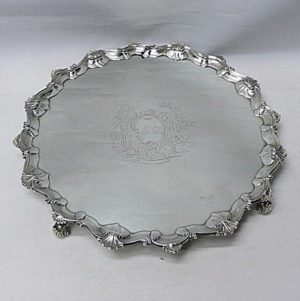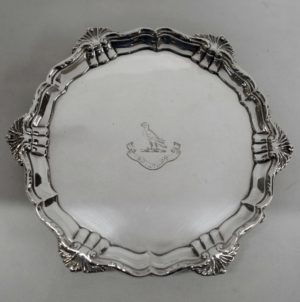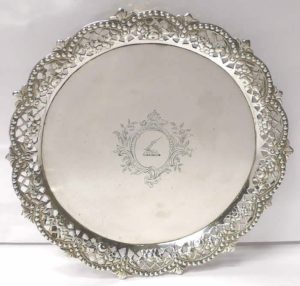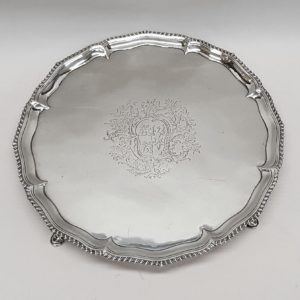Richard Rugg
Richard Rugg I, London silversmith, worked from 1754. Specialist salver maker. His son Richard Rugg II was apprenticed to his father in 1763 and registered his first and only known mark in 1775. The registered mark of Richard Rugg I is very similar to that of Robert Rew, both were prolific salver makers and worked approximately in the same period. The problem of the correct attribution of the R•R mark is well known and this amusing rhyme appeared in the introduction to a Sotheby’s catalogue of provincial silver spoons offered for sale in 1935:
Said Robert Rew to Richard Rugg “RR’s my mark”; but with a shrug
Said Richard Rugg to Robert Rew “I’m RR just as much as you”;
So neither yielded; both held out, And left the question still in doubt
The attribution of a specific mark to a particular maker is sometimes speculative. In a case where the doubt is between two makers of equal importance, like Richard Rugg and Robert Rew, the question may be only of academic interest.
Richard Rugg
Richard Rugg I, London silversmith, worked from 1754. Specialist salver maker. His son Richard Rugg II was apprenticed to his father in 1763 and registered his first and only known mark in 1775. The registered mark of Richard Rugg I is very similar to that of Robert Rew, both were prolific salver makers and worked approximately in the same period. The problem of the correct attribution of the R•R mark is well known and this amusing rhyme appeared in the introduction to a Sotheby’s catalogue of provincial silver spoons offered for sale in 1935:
Said Robert Rew to Richard Rugg “RR’s my mark”; but with a shrug
Said Richard Rugg to Robert Rew “I’m RR just as much as you”;
So neither yielded; both held out, And left the question still in doubt
The attribution of a specific mark to a particular maker is sometimes speculative. In a case where the doubt is between two makers of equal importance, like Richard Rugg and Robert Rew, the question may be only of academic interest.
-


1764
Richard Rugg
8475 George III Silver Salver
Sold
An excellent quality antique sterling silver salver with a scalloped shell border and scroll feet. Good size. The centre has a double hand engraved crest within a finely executed cartouche depicting an English country garden with trees, flowers, garden architecture, fruit, a swan and much more. Weight 1433 grams, 46 troy ounces. Diameter 37.5 cms. Height 3.5 cms. London 1764. Maker Richard Rugg.
-


1754
Richard Rugg
9256 George II Silver Salver
Sold
A good antique sterling silver salver of plain design with a shaped reed and shell border. With contemporary hand engraved armorial and motto. These small size trays are often referred to as waiters and are ideal for use with small objects such as glasses and bottles. Weight 248 grams, 7.9 troy ounces. Diameter 17.5 cms. Height 2.4 cms. London 1754. Maker Richard Rugg.
-


1764
Richard Rugg
7022 George III Silver Salver with Cast Border
Sold
An excellent quality antique sterling silver salver with a decorative cast border. The plain centre has a decorative hand engraved cartouche with a crest of an arm holding a dagger. The pierced border is decorated with roses and has a bead edge. Weight 435 grams, 13.9 troy ounces. Diameter 21 cms. Height 3 cms. London 1764. Maker Richard Rugg or Robert Rew.
-


1767
Richard Rugg
9446 George III Silver Salver
Sold
A good quality antique sterling silver salver with a gadroon border and pad feet. Good size. The centre has a hand engraved coat of arms within a finely executed cartouche. Weight 1183 grams, 38 troy ounces. Diameter 35.5cm. Height 3.8cm. London 1767. Maker Richard Rugg.